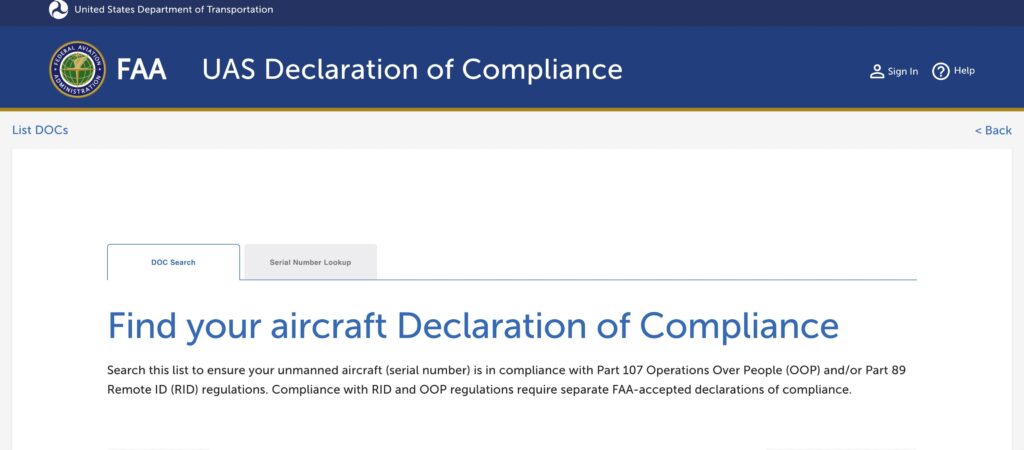The preponderance of (usually well-meaning) bad information spreading around the drone forums these days has prompted me to write this article. Please feel free to share this with those who are fearful or uneducated in the actuality of the upcoming FAA Remote Identification (RID) rule. It’s a bit of a long read, but worth it if you or someone you know is confused about RID.
Come September 16th, 2023, Congressionally mandated sUAS Remote Identification will be the law of the land. At least it will be in the US.
And as per Kevin Morris, FAA’s “Drone Guy”, as quote at the AUVSI XPO this last May, it’s “highly unlikely” that the RID operator compliance date will be pushed back. There are too many drones and modules on the FAA’s Declaration of Compliance (DOC) page.
And there is a TON of misinformation and outright lies being spread on social media. And the more they are spread, the worse it gets. So please do us all a favor and make sure you understand the actual facts about RID before you post “I heard on the Inner Webs…” type information. It may not be correct, and if it’s not, you’re making things worse.
So let’s put so much of that bad information to rest.
First and foremost, if you get nothing else out of this article, remember that RID is tied to registration. That is THE KEY component of RID. More on why later…
And if you’re a glutton for punishment, suffering from insomnia in search of a method to fall asleep, or (like me) are a self-described policy wonk, go here to read the RID Final Rule. Or, you can just peruse the actual regulatory language here . Or, for the FAA’s summary page, check this out.
First, there are three ways to be compliant with RID.
First method of compliance is to fly a drone that qualifies under the Standard Remote ID rule under § 89.301.
From take off to landing, Standard Remote ID drones will be required to broadcast message elements that will include:
- (a) The identity of the unmanned aircraft, consisting of:
- (1) A serial number assigned to the unmanned aircraft by the person responsible for the production of the standard remote identification unmanned aircraft; or
- (2) A session ID.
- (b) An indication of the latitude and longitude of the control station.
- (c) An indication of the geometric altitude of the control station.
- (d) An indication of the latitude and longitude of the unmanned aircraft.
- (e) An indication of the geometric altitude of the unmanned aircraft.
- (f) An indication of the velocity of the unmanned aircraft.
- (g) A time mark identifying the Coordinated Universal Time (UTC) time of applicability of a position source output.
- (h) An indication of the emergency status of the unmanned aircraft.
Second method of compliance is to fly a drone that has an RID Module attached under § 89.115 (a).
From take off to shutdown, the RID Module must broadcast message elements that will include:
- (a) The identity of the unmanned aircraft, consisting of the serial number assigned to the remote identification broadcast module by the person responsible for the production of the remote identification broadcast module.
- (b) An indication of the latitude and longitude of the unmanned aircraft.
- (c) An indication of the geometric altitude of the unmanned aircraft.
- (d) An indication of the velocity of the unmanned aircraft.
- (e) An indication of the latitude and longitude of the take-off location of the unmanned aircraft.
- (f) An indication of the geometric altitude of the take-off location of the unmanned aircraft.
- (g) A time mark identifying the Coordinated Universal Time (UTC) time of applicability of a position source output.
And the third method of legally flying a drone that requires RID, yet doesn’t have RID, is to fly them at an FAA Recognized Identification Area (FRIA) as described under § 89.115 (b). The rules for FRIAs include are pretty basic, and include:
- (1) The unmanned aircraft and the person manipulating the flight controls of the unmanned aircraft system remain within the boundaries of an FAA-recognized identification area throughout the operation; and
- (2) The person manipulating the flight controls of the unmanned aircraft system must be able to see the unmanned aircraft at all times throughout the operation.
Okay, so now that you know the wording of the actual regulations, let’s dive a tad deeper into the minutiae.
All drone that must be equipped with RID must perform a self-test upon start up.
If you are flying a drone equipped with Standard RID, then that RID system is tied to the control system of the drone. And if the RID self test fails, that drone will not lift off. If the RID systems fails during flight, it will notify the operator, and the operator must land “as soon as practicable”. The RID system will NOT force land the drone.
All folks flying a drone that requires an RID Module will also have a self test involved. However, since the module is just an attachment to the drone itself, and not tied to the control system of the drone, it is up to the operator to not fly if the self test fails. Each module will have it’s own system to tell the operator if the RID fails. It could be a blinking red light, maybe an annoying beep, or something else entirely. Check the instructions from your module manufacturer.
If you want to fly a mission that reqires BVLOS, the drone MUST be compliant under the Standard Remote ID. You cannot fly a drone BVLOS if it has an RID Module. And no, that does not mean you can automatically fly a drone BVLOS if it is equipped with Standard RID. It simply means if you want to fly BVLOS, the drone you use must have Standard RID. How you legally accomplish that BVLOS flight would be dependent on your waiver or rules change.
Okay, what if my drone doesn’t require FAA registration, do I need RID (remember, I said more on this later…)?
Short answer is no, it does not. And you can fly that drone anywhere the FAA says it’s legal to fly. And what doesn’t need to be registered? Any drone flown strictly for recreational purposed that weighs under 250g (.55lbs).
Long answer is that it may broadcast the RID message anyway. Since Standard and Module RID units must be “tamper resistant”, that means if your <250g drone is equipped with Standard RID (such as the DJI Mini 3 or Autel Nano), and you’re only going to fly recreationally, the drone will still broadcast it’s RID message. It will do that whether you’re flying under 107 (default rules) or 44809 (the recreational exception), and you can’t turn it off (tamper resistant, remember). But you still do not need to register it under 44809. If you’re flying a <250g drone under 107, and you’re using an RID Module, you are allowed to remove it when you’re flying under 44809.
Is my drone compliant?
That’s an easy thing to check. Simply go to the FAA’s RID DOC page. If it’s listed there, it’s compliant under Standard RID. If it’s not listed there, that list also has all approved RID Modules. Plan accordingly. Search your drone model, or manufacturer.

Some fallacies we’re seeing in the forums…
Rumor: The FAA will record the data and use it for enforcement.
Fact: No they won’t. First, they don’t have the personnel to drive around looking for scofflaws. And second, the drone itself will not have recording capabilities, so there is no investigatory forensic information in the RID history. Because there is none on the drone.
Caveat: RID applications will likely have the ability to record flight info, as will some cities. El Paso, TX announced earlier this year they are a 100% RID motored (and likely recorded) city. So if you fly a drone in El Paso, you’re being watched. But let’s look at El Paso’s airspace. They have a major issue with drugs and people crossing the boarder illegally. I’m willing to bet that’s why they implemented their system.
Rumor: RID will be used by people to find you, no matter how far you are from them.
Fact: RID message will be broadcast via Wifi and/or Bluetooth. Both of those systems are short range, and basically line of sight. So someone will basically have to be able to see the drone to really capture the RID message on their apps.
Rumor: RID is the end of our hobby or industry
Fact: I will politely say, “BOVINE SCAT”. This is being spread by the likes of Kiwi YouTubers who have nothing better to do than complain about life. Does RID need work? Yes. Will it end drone use in the U.S? See first comment in this paragraph.
Rumor: The RID modules can be moved from aircraft to aircraft.
Fact: Yes.
Caveat: If you’re flying under 44809 (recreational exception), your RID module is tied to you, not the actual aircraft. So just like your 44809 registration number, it can be applied (attached) to any or all aircraft flown under 44809. If you’re flying the RID Module equipped drone under 107, then you can still move the same module from aircraft to aircraft, but since it’s actually tied to the aircraft, and NOT the pilot, you them have to re-register your drone in your Drone Zone account before you can fly. It’s only $5, but it is a pain in the sit upon. It’s up to you if you want to get a module for each to your drones so requiring them, or re-register them each time you want to put that module on a different aircraft.
Rumor: My DJI has “Remote ID” already built in, it says so in the app.
Fact: Unfortunately, DJI’s version of Remote ID and the FAA’s version of Remote ID are not the same thing. They’re just unfortunately named the same thing. If your DJI drone is not listed on the FAA’s DOC page, then it is not compliant after 9/16/23.
Rumor: “My drone now has RID, I can fly over people!”
Fact: Not necessarily. IF you have an OOP compliant drone (OOP article), AND your drone has RID, you can in fact fly that drone for a “sustained flight over open-air assemblies”. And no, we’re not going to go into the definition of “sustained flight” here. We already have an article about that here.
Rumor: The FAA (or manufacturer) is going to brick my drone if I don’t have RID on September 16, 2023.
Fact: No, of course not. First, why would they? Second, how would they know if you’re not flying in a FRIA, don’t require registration, or have an RID Module on board. So put this one to rest whenever you see it. People need to quit being paranoid about it!
Rumor: If your drone doesn’t have RID, the cops will come arrest you.
Fact: No they won’t. First, they don’t have the authority to do so. At worst, they’ll take all of your information down and forward it to FSDO or LEAP. So don’t stress about that. They may ask you to not fly, and quite possibly have the authority to enforce that request (that would be dependent on local laws), so it’s a good idea to not fly if they say so. It would be illegal under the RID regulations anyway. And any interaction is likely going to be because someone called and complained about a drone. So be prepared to help them understand the rules as well.
Rumor: Everyone will know our names and contact info.
Fact: No, they won’t. The RID packed will not broadcast any personal information. The only identifiable piece of information will be your RID serial number. And that can be used to get your personal information. But only by an officer of the court who shows the FAA just reason for needing that information. Just like the license plate on your car, it is traceable. But just like the license plate on your car, John Q. Public is not privy to your personal information. That must be obtained by an LEO showing cause. And with RID, there is the added layer of defense against misuse.
Rumor: Manufacturers will (or will not) update their drones via firmware.
Fact: Maybe, but that depends on any number of things, including if the drone and controller are capable of compliance, and/or the manufacturer is willing to put the money into reprogramming their drones via update to be RID compliant.
[edit]: On 7/1/23, DJI put out a press release stating their DJI FPV, Mavic Air 2, Mavic 2 Zoom, Mavic 2 Pro, and Phantom 4 Pro v2.0 will all become RID compliant by 12/31/23. Full list here.
Editorial comment: Personally, if manufacturers were to put out a paid update that would make my currently non-compliant drone RID compliant, I’d be willing to pay a small fee for that. It would be cheaper and easier than going the RID Module route.
Rumor: Old drones will be “Grandfathered” in and won’t need RID.
Fact: No they won’t. That is the reason for the RID Module. You’ll need one of those if your drone requires registration after 9/16/23.
Rumor: You can fly a drone that falls under the Standard RID category under BVLOS conditions.
Fact: No. The mention of BVLOS flights for Standard RID drones simply means if you do get a BVLOS waiver (it’s still required), then you’ll need to only use Standard RID drones. Drones with an RID Module may not be used for BVLOS operations.
Final Rumor: Every person on the planet will have an RID app so they can hunt us down and make our lives miserable.
Final Fact: No. But that still doesn’t alleviate the real and true danger of an anti-drone freak coming after us to possible cause an issue. And since Apple iOS isn’t optimized for RID Apps, that cuts down 50% of the population from utilizing those apps anyway.
I leave you with this.
RID must broadcast pilot location or launch point. That is mandated in the regulatory language. But RID App makers are not required to show it to everyone. Air Sentinel will not show pilot location to everyone who has the app. Their free version will not show it. But paid version will, and that version will only be available to those who qualify for it, and pay for it.
I query other RID app makers this. If someone uses your app to find the location of a pilot or operator, with the sole intent on doing harm to the drone or the operator, are you liable? Are you complicit in the incident since you gave the person intent on harm the information necessary to carry out that harm? Can the victim file suit against you? After all, the FCC forbids using radio frequencies in the commission of a crime. Is the one who supplied that information liable? Inquiring minds want to know.
Something to think about.
And honestly, you’d be doing the industry a huge favor if you have a two tier structure to your app or dongle. Every Gladys Kravitz out there has no need to know our locations. Please consider helping keep this industry and hobby safe from the Mrs. Kravitzes of the world. We can’t just wiggle our noses and make them go away.
Hopefully this article helps calm some nerves, or at the very least help spread the correct information about the upcoming FAA Remote Identification compliance date.
____________________________________________________________________________
Drone Service Providers Alliance provides “Professional advocacy for Drone Service Providers throughout the United States”. Our mission statement is “A United Voice for Positive Change”. We are a dues supported 501(c)(6) organization. Dues are used to cover travel and operating expenses. No salaries are taken by Kenji and Vic for the work they do on behalf of the US UAS industry. We fully believe a rising tide raises all boats. And since we also fly drones for a living, it will benefit us as well.
If you believe in what we do, please consider joining us, we appreciate any and all support: https://dspalliance.org/join-us/
Also, have you added to your drone fleet? Do you know the ins and outs of your new drone? Check out Pilot Institute’s Deep Dive Videos. Greg and crew do an great job helping you understand your drone better. And each and every Deep Dive Video is free.
Also, if you don’t have your 107 yet, or are looking to add UAS Verticals, check out the Pilot Institute site for additional classes. They have business classes, a VO class (pay for your VOs to take it), mapping, photography, and more. Check out their offerings here!
And as always FLY SAFE!




Pingback: Remote ID is coming - here is everything you need to know. - Avios Media